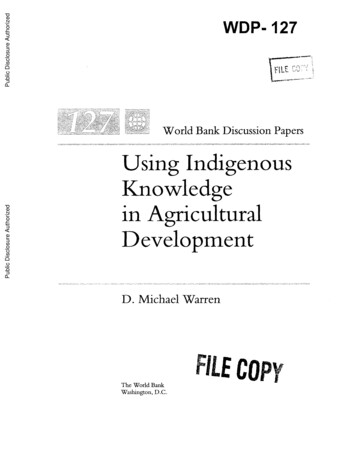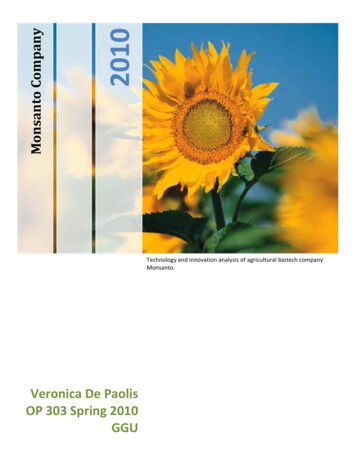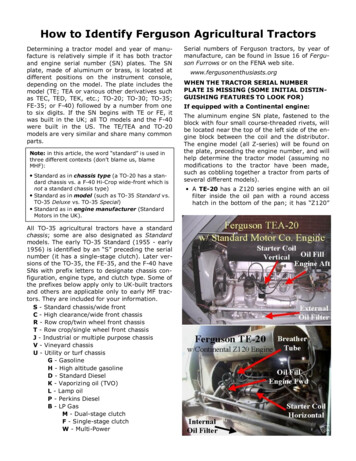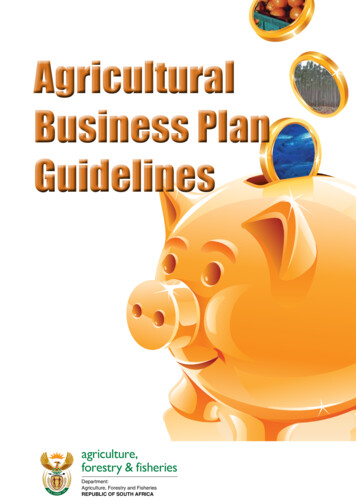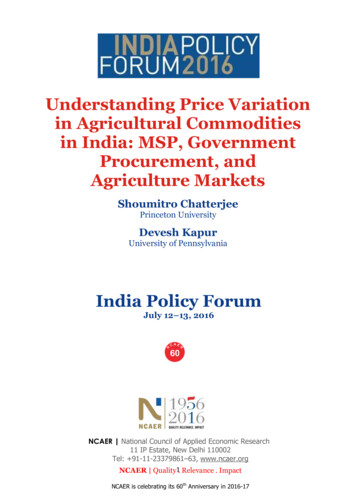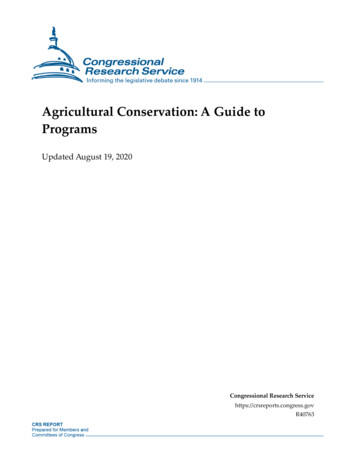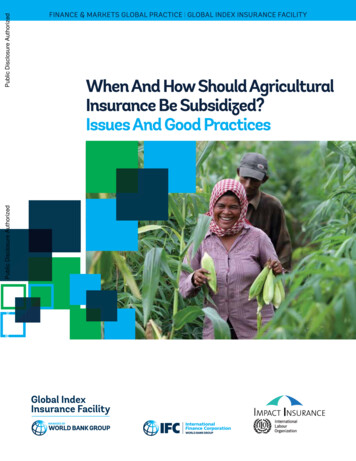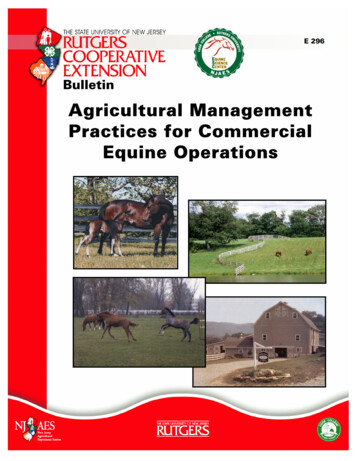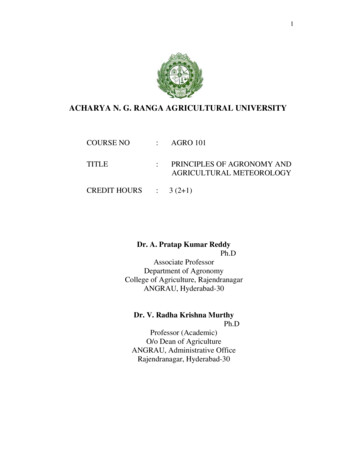
Transcription
1ACHARYA N. G. RANGA AGRICULTURAL UNIVERSITYCOURSE NO:AGRO 101TITLE:PRINCIPLES OF AGRONOMY ANDAGRICULTURAL METEOROLOGYCREDIT HOURS:3 (2 1)Dr. A. Pratap Kumar ReddyPh.DAssociate ProfessorDepartment of AgronomyCollege of Agriculture, RajendranagarANGRAU, Hyderabad-30Dr. V. Radha Krishna MurthyPh.DProfessor (Academic)O/o Dean of AgricultureANGRAU, Administrative OfficeRajendranagar, Hyderabad-30
2DEPARTMENT OF AGRONOMY1. Course No.:AGRO 1012. Course Title:Principles of Agronomy and AgriculturalMeteorology3. Credit Hours:3 (2 1)4. General Objective:To impart knowledge on principles ofagronomy and agricultural meteorology5. Specific Objectives:a) TheoryBy the end of the course, the students will be able toi.understand the concepts of agronomy and agricultural meteorologyii.know about the situation of agriculture in various agro-climatic zones ofIndia and Andhra Pradeshiii. discuss the risks and uncertainties and ways to manage the same for bettercrop productionb) PracticalBy the end of the practical exercises, the students will be able toi.identify different manures, fertilizers, green manure plants etc.ii.participate in all agricultural operations like ploughing, puddling, sowing,application of fertilizers, harvesting etc.A) Theory Lecture Outlines1.Definition of agriculture – meaning and scope of agronomy2.History and development of agriculture in ancient India – agriculture incivilization era3.National and International Agricultural Research Institutes in India4.Agro-climatic zones of India – soils, land use pattern, major sources ofirrigation and ground water potential5.Agro-climatic zones of Andhra Pradesh – soils, land use pattern, major sourcesof irrigation and ground water potential.
36.Tillage and tilth – objectives of tillage – characteristics of ideal seed bed – effectof tillage on soil properties – pore space, texture, structure, bulk density andcolour of the soil7.Types of tillage – preparatory tillage – factors affecting preparatory cultivation,after cultivation, puddling8.Sowing – methods of sowing – time and depth of sowing for major agriculturalcrops – cereals, pulses and oilseeds9.10.Crop stand establishment – factors affecting optimum stand establishmentPlanting geometry – competition – types of competition, intra and inter plantcompetition – plant population – effect of plant population on growth and yield –optimum plant density and planting pattern11.Soil fertility – soil fertility and soil productivity – fertility losses – maintenanceof soil fertility – soil organic matter12.Weed control – definition of weed – losses and uses of weeds – weed influenceon crop production – methods of wed control13.Irrigation management – importance of irrigation – objectives of irrigation –methods of irrigation – drainage and its advantages14.Cropping systems – monocropping – definition and principles of crop rotation –mixed cropping – intercropping – relay cropping – multistoried cropping – solecropping and sequence cropping15.Harvest maturity symptoms and harvesting of major agricultural crops – rice,maize, groundnut, sugarcane and pulses – maturity indices, method of harvesting,threshing and winnowing – harvest index16.Agricultural meteorology – introduction – definitions of meteorology,climatology and agricultural meteorology – scope and practical utility ofagricultural meteorology17.Composition and structure of atmosphere – definitions of weather and climate –aspects involved in weather and climate18.Solar radiation – definition, introduction of electromagnetic spectrum andfunctions of light, solar constant, net radiation, black body radiation, emissivity,absorptivity, reflectivity, transmissivity and albedo19.Physiological response of different bands of incident radiation – factors affectingdistribution of solar radiation within the plant canopy
420.Air temperature – introduction – temperature and heat definitions – isotherms –horizontal and vertical temperature variations in the atmosphere – cardinaltemperatures – importance of air temperature21.Low air temperature and plant injury – high air temperature and plant injury –soil temperature – factors affecting soil temperature22.Definitions of atmospheric pressure, cyclones – anticyclones – pressure patterns– wind – effects of wind on crops – mountain and valley winds – land and seabreezes23.Atmospheric humidity and its expression – saturation – effects of humidity oncrops24.Evaporation and transpiration – definitions – factors affecting rate of evaporationand transpiration25.Rainfall – importance of rainfall on crops – types of rainfall – monsoon –definition –origin and distribution of south west monsoon26.Origin and distribution of north east monsoon – economic importance andinfluence of monsoon rains on farm operation27.Clouds – cloud formation – cloud classification and characteristics – WorldMeteorological Organization (WMO)28.Drought – definition – types of drought – effect of drought on crops –management of drought29.Precipitation and condensation – definition, different forms of precipitations andcondensations – cloud seeding (artificial rain making)30.Weather disasters and management – rainfall, heat and cold waves, windstorms,hail storms, thunderstorms, dust storms, tornadoes and defective insolation31.Weather forecasting – applications and utility for agriculture – synoptic charts,reports and symbols32.Remote sensing – definition – introduction – applications in agricultureB) Practical Class Outlines1.Study of tillage implements2.Practice of ploughing3.Practice of puddling4.Study of seeding equipment – different methods of sowing
55.Study of manures, fertilizers and green manure crops / seeds6.Study of inter-cultivation implements and practice7.Practice of methods of fertilizer application8.Participation in ongoing field operations9.Visit to meteorological observatory – layout plan of standard meteorologicalobservatory10.Measurement of light intensity / radiation components11.Recording of atmospheric and soil temperature12.Recording of relative humidity13.Measurement of wind speed, direction and measurement of atmosphericpressure14.Recording of evaporation15.Measurement of rainfall – different types of rain-gauges16.Synoptic charts and weather reports, symbols etc.ReferencesRadha Krishna Murthy, V., Yakadri, M. and Prasad, P.V.V. 2006. Terminology onAgricultural Meteorology and Agronomy. B.S. Publications, Hyderabad.Radha Krishna Murthy, V. 2002. Basic Principles of Agricultural Meteorology. B.S.Publications, Hyderabad.Yellamanda Reddy, T. and Sankara Reddi, G.H. 2010. Principles of Agronomy.Kalyani Publishers, Ludhiana.
6LECTURE NO – 1DEFINITION OF AGRICULTURE, MEANING AND SCOPEOF AGRONOMYThe term agriculture is derived from the Latin words “ager” or “agri” meaning“soil” and ‘cultra’ meaning ‘cultivation’Agriculture is a very broad term encompassing all aspects of crop production,livestock farming, fisheries, forestry etc.Agriculture may be defined as the art, the science and the business of producingcrops and livestock for man’s use and employment.Agriculture is the cultivation of lands for production of crops for a regularsupply of food and other needs for progress of the nation.Agriculture is influenced by a large number of factors, some of which can becontrolled by man (soil and irrigation) which others are beyond the control (climate)The term “Agronomy” is derived from Greek words “Agros” meaning “field”and “nomos” meaning “to manage”Agronomy is a branch of agricultural science which deals with principles andpractices of soil, water and crop management.Agronomy deals with methods which provide favourable environment to thecrop for higher productivity.Importance of basic sciences for development of Agricultural science Basic science is the study of basic principles and fundamentals of the respectivesubject. Applied science is the study in which the basic principles and fundamentals ofrespective subject are applied in a practical field. Agricultural sciences are essentially applied sciences and are dependent onbasic sciences of Botany, Physiology, bio-chemistry, ecology, zoology,chemistry, physics, mathematics, economics etc.For example1. Knowledge of Botany is helpful in plant breeding and plant genetics and ismaking possible for evolution of different varieties in crops suitable toparticular agro-climatic condition.2. The knowledge of zoology (basic science of entomology) is helping the farmerto identify the insect pests which are responsible for damage to agriculturalproduce.3. Soil chemistry helps in understanding the plant nutrient status in the soil and thedeficiency symptoms in plants.
74. physics helps in understanding the weather phenomena and soil conditions5. Mathematics is helpful in agricultural research and experimentation throughstatistics and Agricultural economics.6. Study of economics is helpful in estimating the cost and returns and existingconditions of farmers in villages for effecting the improvements.Without basic science there can be no development in applied science. In thefield of Agriculture basic and applied sciences are interrelated to each other.Scope of AgronomyAgronomy is a dynamic discipline. With the advancement of knowledge andbetter understanding of plant and environment, agricultural practices are modified andnew practices are developed for high productivity. For example, availability ofchemical fertilizer has necessitated the generation of knowledge on the method,quantity and time of application of fertilizers. Similarly, availability of herbicides forthe control of weeds has led to development of knowledge about selectivity, time andmethod of application of herbicides. To overcome the problems different managementpractices are developed.Population pressure is increasing but area under cultivation is static, thereforemore number of crops have to be grown on the same piece of land to increase the yield.As a result, intensive cropping has come into practice.New technology has to be developed to overcome the effect of moisture stressunder dryland conditions. As new varieties of crops with high yield potential becomeavailable, package of practices have to be developed to exploit their full potential.Restoration of soil fertility, preparation of good seed bed, use of proper seedrates, correct dates of sowing for each improved variety, proper conservation andmanagement of soil moisture and proper control of weeds are agronomic practices tomake our limited land and water resources more productive.Relation of Agronomy to other sciencesAgronomy is a synthesis of several disciplines like soil science, Agriculturalchemistry, crop physiology, plant ecology, biochemistry and economics. Soil physical,chemical and biological properties have to be understood thoroughly to effectmodification of soil environment. Similarly it is necessary to understand the physiologyof crops to meet their requirements. Advances in economic analysis helped inproduction of crops economically.Agronomist aims to obtain maximum production at minimum cost. He exploitsthe knowledge developed by basic and applied science for higher crop production.Whatever may be the research findings of other scientists, agronomist has to test theirsuitability in the field and accept them finally and also judge the reactions of farmingcommunity. He is a key person with working knowledge of all agricultural disciplinesand coordinator of different subject matter specialists.
8LECTURE NO-2HISTORY AND DEVELOPMENT OF AGRICULTURE INANCIENT INDIA- AGRICULTURE IN CIVILIZATION ERAAgriculture began some 10,000 years ago.The successional stages in food procurement and production appear to be asfollows:Hunting and GatheringDomestication (of animals and plants)Root crop cultureShifting cultivationSubsistence AgricultureCommercial Agriculture-Agriculture was very important profession during Vedic age.-Buddhist period (600BC) marked the importance of trees.-Irrigated agriculture with rice was started in south India during 300 A.D.-Amarakosha written during the period of Chandra Gupta – II containedinformation on soil, irrigation, implements, manures and land use.-History of agriculture from 9th to 11th century is evident from Krishi –Parashara written by “Parashara” (950-1100AD)-Modern Agriculture was started during early 19th century but was confinedto western countries.-Most developments in India started after independence-At the time of independence, cultivated area in India was 98.5 m. ha. Andirrigated area was 19.4 m. ha (out of 329 m. ha of geographical area).-Now the total cultivated area is 143 m. ha and the gross irrigated areaincreased to 82.6 m. ha (2005-06).
9Net irrigated area (mha) under different 5Wells and ZERS:Fertilizers consumption in India11951-52-0.07m.t21969-70-1.98 m.t32005-06-35.45 m.t42006-07-38.03 m.t(18.1 – kharif, 19.9 Rabi)Consumption per unit area-Consumption ratio for150kg/haN-P-K8.4:2.5:1.0The required N and P fertilizers are produced in our country while K fertilizersare totally -?Average use-429 g/haConsumption of-2006-07-41515 m. t(India)Pesticides
10HYV’S AND HYBRIDS:India witnessed green revolution in 1960’s and 70’s particularly through wheatcrop. It is due to dwarfing gene “NORIN”.India also witnessed white revolution with milk. Blue revolution withAquaculture and partial success of Yellow revolution with oil seedsNow it is being programmed for Rainbow Revolution.Apart from traditional breeding programmes, new varieties were evolved usingother techniques like use of Radio-isotopes. Biotechnology etc.Now we also have GM plants.NON-TRADITIONAL CROPS AND INTROUDUCED CROPS:Rice is grown in Punjab with very good yields and wheat yields are very goodin South and Eastern India (Non-traditional areas) Crops like sunflower, soya bean andoil palm are introduced into India and now occupy considerable area.MECHANIZATION:9 Cattles are replaced to a great extent by Tractor.Tractors (m)Oil engines (m)Electrical pumps (m)1950-510.010.070.02?2.634.909.809 Use of seed drills has picked up.9 New planting equipments introduced into the country include potato planter,groundnut planter, rice transplanter, sugar cane sett cutter – cum- planter.9 Now combines are put to use for the harvest of wheat, rice, soya bean and gram.9 One important obstacle in the way of mechanization in India is the size ofoperational holding. The average farm size in India is 1.57 ha.In other countries:1993 ha in Australia158 ha in USA55 ha in UK1.0 ha in JapanWATERSHED PROGRAMMES:Water shed programmes for soil and moisture conservation have been taken up.Anna Hazare in Maharashtra (Ralegaon siddi) Rajendra Singh in Rajasthan worked onwatersheds.Weather forecasting systems are improved due to the use of satellitecommunications, particularly the short range forecast.
11Agricultural Extension:In A.P DAATT (District Agricultural Advisory and Transfer of Technology)centers and “Rytu Mitra” T.V programmes are educating the farmers about the bettermanagement practices.
12LECTURE NO - 3NATIONAL AND INTERNATIONAL RESEARCHINSTITUTES IN INDIANATIONAL RESEARCH INSTITUTES:CAZRI: Central Arid Zone Research Institute, Jodhpur, RajasthanCFTRI: Central Food Technological Research Institute, Mysore, KarnatakaCICR: Central Institute for Cotton Research, Nagpur, MaharashtraCPRI: Central Potato Research Institute, Simla, H.P.CRIJAF: Central Research Institute for Jute and Allied Fibres, Barrackpore,W.B.CIAE: Central Institute of Agricultural Engineering, Bhopal, M.P.CPCRI: Central Plantation crops Research Institute, Kasargod, KeralaCRIDA: Central Research Institute for Dryland Agriculture, Hyderabad, A.P.CRRI: Central Rice Research Institute, Cuttack, OrissaCSWCRTI : Central Soil and Water Conservation Research and Training Institute,Dehradun, U.P.CTCRI: Central Tuber Crops Research Institute, Thiruvananthapuram,(Trivendrum), KeralaCSSRI: Central Soil Salinity Research Institute, Karnal, HaryanaCTRI: Central Tobacco Research Institute, Rajahmundry, A.P.DOR: Directorate of Oilseeds Research, Hyderabad, A.P.DRR: Directorate of Rice Research, Hyderabad, A.P.DWR: Directorate of Wheat Research, Karnal, HaryanaDWMR: Directorate of Water Management Research Institute, Jhansi, U.P.FRI: Forest Research Institute, Dehradun, U.P.IARI: Indian Agricultural Research Institute, Pusa, New DelhiIGFARI: Indian Grassland Fooder and Agroforestry Research Institute, Jhansi,U. P.IISR: Indian Institute of Sugarcane Research, Lucknow, U.P.IISS: Indian Institute of Soil Science, Bhopal, M.P.IIPR: Indian Institute of Pulses Research, Kanpur, U.P.IIHR: Indian Institute of Horticultural Research, Bangalore, Karnataka.ILRI: Indian Lac Research Institute, Ranchi, BiharJTRL: Jute Technological Research Laboratory, Kolkata, W.B.
13NCMRT: National Centre for Mushroom Research and Training, Solan, H.P.NRCG: National Research Centre for Groundnut, Junagadh, GujaratNRCS: National Research Centre for Sorghum, (Directorate of SorghumResearch) Hyderabad, A.P.NRC for Soybean, Indore, M.P.NRC for Spices, Calicut, KeralaNRC for Cashew, Pattur, KarnatakaNRC for Citrus, Nagpur, MaharasthraNRC for Rapeseed and Mustard, Bharatpur, RajasthanNRC for Oil Palm, Pedavegi, Andhra Pradesh.NCWS: National Centre for Weed Science, Jabalpur, M.P.NBPGR: National Bureau of Plant Genetic Resources, New DelhiNAARM: National Academy of Agricultural Research Management, HyderabadNBSSLUP : National Bureau of Soil Survey and Land Use Planning, Nagpur,MaharashtraNPPTI: National Plant Protection Training Institute, National Institute of plant vHealth Management, Hyderabad, A.P.-NIPHM.PDCSR: Project Directorate for Cropping Systems Research, Meerut, U.P.SBI: Sugarcane Breeding Institute, Coimbatore, Tamil NaduINTERNATIONAL INSTITUTES:CGIAR: Consultative Group on International Agricultural Research,Washington, D.C.CIFOR: Centre for International Forestry Research, Bogor, IndonesiaCIAT: Centre International de Agricultural Tropical, Cali, ColumbiaCIMMYT : Centre International de la Mejoramientode Maizy Trigo, MexicoCIP: Centre International de la papa (International Potato Centre) Lima,PeruIPGRI: International Plant Genetic Resources InstitiuteIBPGR: International Board for Plant Genetic Resources, Rome, ItalyICARDA: International Center for Agricultural Research in the Dry Areas,Aleppo, SyriaICRAF: International Centre for Research in Agro-Forestry, Nairobi, KenyaICRISAT: International Crops Research Institute for Semi-Arid Tropics,Hyderabad, IndiaIFPRI: International Food Policy Research Institute, Washington, U.S.AIITA: International Institute for Tropical Agriculture, Ibadan, NigeriaIWMI/IIMI : International Irrigation Management Institute, Colombo, Sri Lanka
14ICRISATILRIIRRIISNAR::::On waterInternational Livestock Research Institute, Nairobi, KenyaInternational Rice Research Institute, Manila, PhilippinessInternational Service for National Agricultural Research, The Hague,The NetherlandsWARDA: West Africa Rice Development Association, Ivory Coast, West AfricaIMPORTANCE EVENTS OF AGRICULTURE IN INDIA1788First attempt at cotton crop improvement in Bombay province1827First agricultural society at Calcutta1864First model agricultural farm at Saidapet, Tamil Nadu1871Department of Agriculture created1878Higher Education in Agriculture at Coimbatore1880First Report of Famine Commission (Famine during 1876-771893Second report of Famine Commission1901Third report of Famine Commission1901First Irrigation Commission1902Introduction of large scale cultivation of groundnut1903Imperial Agricultural research Institute at Pusa, Bihar1904Introduction of Cambodia cotton1912Imperial Sugarcane Breeding Station at Coimbatore1926Royal Commission on Agriculture1929Imperial (Indian) Council of Agricultural Research at Delhi1936IARI shifted to Delhi1942Grow More Food Campaign1946Central Rice Research Institute1947Fertilisers and Chemicals, Travancore1956Project for Intensification of Regional Research on Cotton, Oilseeds andMillets (PIRRCOM)1960Intensive Agriculture District Programme (IADP)1963National Seed Corporation1965Intensive Agriculture Area Programme (IIAP)1965National Demonstration Programme1965All India Coordinated Rice Improvement Project, (AICRIP) Hyderabad1966HYV Programme1966Multiple Cropping Schemes1970Drought Prone Area Programme (DPAP)1971All India Coordinated Project for Dryland Agriculture
151972ICRISAT1973Minikit Trails Programme1974Command Area Development (CAD)1975Release of first cotton hybrid in India1976Report of National Commission on Agriculture1976Integrated Rural Development Programme (IRDP)1977Training and Visit (T&V) System1979National Agriculture Research Project (NARP)1982National Bank for Agriculture and Rural Development (NABARD)1986Establishment of Technology mission on oilseeds1993Release of First rice hybrid in India1998National Agricultural Technology Project (NATP)ITDA-Integrated Tribal Development AgencySFDA-Small Farmers Development AgencyHADP-Hill Area Development Project Special Programme for HorticulturalCropsDRDA -District Rural Development AgencyFunctions of ICAR: Coordinating Agricultural activity between states and center,financing research problems, maintaining National ResearchCenters and InstitutesAgricultural research is carried out by:ICAR research centersSAUs (State Agricultural Universities)State Government Research CentersPrivate agencies (Please find out different agricultural universities in India and their location)
16LECTURE NO – 4AGRO-CLIMATIC ZONES OF INDIABased on the criteria of homogeneity in agro-characteristics such as rainfall,temperature, soil, topography, cropping and farming systems and water resources, thecountry has been divided into 15 agro-climatic regions.1. WESTERN HIMALAYAN REGION:This consists of three distinct sub-zones of Jammu and Kashmir, HimachalPradesh and Uttar Pradesh hills. The region consists of skeletal soils of cold region,podsolic soils, mountain meadow soils and hilly brown soils. Lands of the region havesteep slopes in undulating terrain. Soils are generally silty loam with altitudinalvariations. They are prone to erosion hazards and slides and slips are quite common.Rice, maize, millets, wheat and barley are the main crops. The productivitylevel of all crops is lower than the all India average. Ginger, saffron, many temperateflowers and vegetables are grown in this region. This zone is having highest area(45.3%) under forests.Land use planting based on the concept that land up to 30% slope is suitable foragriculture on terraces, 30-50% slopes for horticulture and silvi-pastoral programmes,and above 50% slopes for forestry is a suggested strategy for development of theregion.With the full backing of storage and cold storage facilities for transport,marketing and processing, this region will be able to supply fruits and vegetables to restof the country.2. EASTERN HIMALAYAN REGIONSikkim and Darjeeling hills, Arunachal Pradesh, Meghalaya, Nagaland,Manipur, Tripura, Mizoram, Assam and Jalpaiguri and coochbehar districts of WestBengal fall under this region, having high rainfall and high forest cover. Shiftingcultivation (Jhum), practiced in nearly one third of the cultivated area, has causeddenudation and degradation of soils, increasing in heavy runoff, massive soil erosionand floods in the lower reaches and basins.
17Since this area has a high potential for agriculture including forestry andhorticulture, a complete package of supply of inputs (quality seeds, saplings, fertilizersand pesticides) coupled with marketing and processing, has to be organized for eachsub-zone.3. LOWER GANGETIC PLAINSThe West Bengal – Lower Gangetic Plains region consists of four sub-regions.This zone accounts for about 12% of the country’s rice production. Floods andinundation of fields in Barind and Central plains often destroy standing crops.Sesamum, Jute, mustard, rabi maize and potato are emerging as new crops of this zone.The per capita land availability here is very low (0.095 hectares) as this zone hashighest density of population (692 per km2). Marine fisheries programmes are welldeveloped but need to be more organized. Scope for forage production and livestockrearing is very high.4. MIDDLE GANGETIC PLAINS:This zone consists of 12 districts of eastern Uttar Pradesh and 27 districts ofBihar plains. Eastern U.P. has been further sub-divided into nine regions based on theheterogeneity in soil, land use, topography and climatic factors. This region has ageographical area of 16 m. ha. and a high population of 85 millions. The rainfall is highand 30% of the gross cropped area is irrigated and the cropping intensity is 142%.There is large area under salt affected (usar) lands. Rice is the principal crop butits productivity is low. Zinc deficiency in rice is wide spread. There is urgent need toimprove the yield, through a technological backup along with supply of seeds of highyielding varieties and adoption of improved package of practices by the farmers. It issuggested to put unculturable wasteland under silvi-pasture and culturable land underagro-forestry.Poultry, dairying and inland riverine fishery also should receive priority
18Agro climatic zones of India
19.5. UPPER GANGETIC PLAINS:This zone consists of 32 districts of Uttar Pradesh divided into three sub-zonesof Central, North- West and South –West U.P. The zone has 144% cropping intensity.Irrigation is largely through canals and tube wells. A good potential forexploitation of ground water exists. Growth in agriculture has to come throughincreasing productivity as net sown area is already exploited. In all the Diara lands(flood prone areas) development of fruit trees is important. Milk production from cowsis very low. Genetic improvement through cross breeding and increasing the area underfodder crops is important.6. TRANS-GANGETIC PLAINSThis zone consists of Punjab and Haryana, Delhi, Union Territories of andChandigarh and Sriganganagar district of Rajasthan. It is delineated into three subzones, namely, foothills of Shiwalik and the Himalayas, plains (Semi arid) and aridzone bordering the Thar desert. The major characteristics of the area are: highest netsown area, highest irrigated area, least poverty level, high cropping intensity (170%)and high ground water utilization.Rice-wheat system is prevalent. There is need to evolve short durationgenotypes and also to diversify of the cropping. Food processing industries should beestablished in areas where farmers have started taking up cultivation of vegetables andfruit crops.7. EASTERN PLATEAU AND HILLSThe eastern Plateau and Hills region consists of the following sub-regions:I. Sub-region of Wainganga, Madhya Pradesh Eastern Hills and Orissainland,II. Orissa Northern and M.P. Eastern Hills and plateauIII. Chotanagpur North and Eastern Hills and plateauIV. Chotanagpur South and West Bengal Hills and Plateau, andV. Chattisgarh and South-Western Orissa Hills.
20The soils of the region are shallow and medium in depth and the topography isundulating with a slope of 1 to 10%. Rainfall is nearly 1300 mm. Integrated watersheddevelopment approach to conserve soil and rainwater should be strengthened.Tank irrigation is significant for sub-zone 2 and sub-zone 5. Irrigation by tubewells is significant in sub-zone 1.In kharif, 82% of the area is under rice. Most soils are acidic and in some areasapplication of lime is necessary. Cultivation of crops like redgram, groundnut, andsoybean in uplands is to be encouraged. Mustard and vegetables are to be grown inirrigated areas.The rehabilitation of degraded peripheral forests is to be taken up on a largescale. Nearly 30% of the forestland is estimated as degraded. Inland fisheriesprogramme needs to be encouraged.8. CENTRAL PLATEAU AND HILLSThis zone comprises of 46 districts of Madhya Pradesh, Uttar Pradesh andRajasthan. Irrigation and intensity of cropping are low. The literacy percentage is lowand the poverty ratio is high. Per capita availability of land is very high (0.446 ha).Since 75% of the area is rainfed, a watershed management programme is to beimplemented. Food crops should be replaced by oil seeds.9. WESTERN PLATEAU AND HILLSThis zone comprises of major parts of Maharashtra, parts of Madhya Pradeshand one district of Rajasthan and is divided into four sub-zones. This region forms amajor part of peninsular India, with an annual average rainfall of 904 mm. Net sownarea is 65% and only 12.4% area is irrigated. Sorghum and Cotton are the major cropsin nearly half of the cultivated area.This zone is known for the best quality oranges, grapes and bananas. The areaunder fruit crops is about one lakh hectares.Farmers are adopting sprinklers and the drip methods of irrigation, particularly,for fruit and vegetable crops.10. SOUTHERN PLATEAU AND HILLS:This zone comprises of 35 districts of Andhra Pradesh, Karnataka and TamilNadu, which are typically semi-arid zones. Rainfed farming is adopted in 81% of the
21area and the cropping intensity is 111%. Low value cereals and minor milletspredominate in the cropping systems.The adoption of proven dryland technology in the watershed areas should aidagriculture in this area.Crop diversification has to be intensified and crops that require less moistureshould be preferred. Poultry has developed quickly in many areas of the zone.11. EAST COAST PLAINS AND HILLS:This zone consists of six sub-zones i) Orissa coastal ii) North Coastal Andhraand Ganjam, iii) South Coastal Andhra, iv) North Coastal Tamil Nadu, v) Thanjavurand vi) South Coastal Tamil Nadu. Rice and groundnut are the important crops.Nearly 70% of the cultivated area does not have irrigation facility and,therefore, a watershed management programme can be taken up to 6.45 m. ha. Tanksaccount for ne
The term “Agronomy” is derived from Greek words “Agros” meaning “field” and “nomos” meaning “to manage” Agronomy is a branch of agricultural science which deals with principles and practices of soil, water and crop management. Agronomy deals with methods which provide fa
